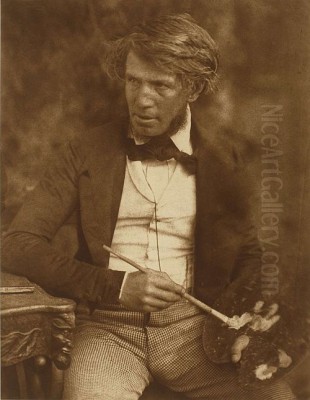
Horatio McCulloch stands as one of the most significant figures in nineteenth-century Scottish art. A landscape painter of considerable renown, he dedicated his career to capturing the dramatic beauty and romantic spirit of his native Scotland, particularly the Highlands. Born in Glasgow in 1805 and passing away in Edinburgh in 1867, McCulloch's life spanned a period of immense change in Scotland, witnessing the rise of industrialisation alongside a burgeoning romantic fascination with the nation's wilder landscapes. His work not only reflected but also profoundly shaped the popular image of Scotland, creating visual counterparts to the literary descriptions penned by contemporaries like Sir Walter Scott. McCulloch's legacy is that of an artist who defined a national landscape style, leaving behind a body of work celebrated for its grandeur, atmosphere, and deep connection to the Scottish identity.
Early Life and Artistic Beginnings
Horatio McCulloch entered the world in Glasgow, the son of a merchant, Alexander McCulloch. His initial foray into the art world was practical rather than purely aesthetic. Around 1824, he secured a position in the studio of the Glasgow landscape painter John Knox. This apprenticeship, though lasting only about a year, provided McCulloch with foundational skills and exposed him to the burgeoning tradition of Scottish landscape painting. Knox himself was a notable figure, known for his panoramic views and detailed depictions of the Scottish scenery, offering a solid starting point for the young artist.
Following his time with Knox, McCulloch's path took him into the realm of decorative arts. He found employment, alongside his friend and fellow Knox student Daniel Macnee, in Cumnock, Ayrshire. Their task involved painting decorative lids for snuff-boxes, a common craft at the time. This period also saw him working with William Leighton Leitch, another aspiring artist who would later gain fame as a watercolourist. This early experience in decorative painting, though seemingly modest, likely honed McCulloch's skills in composition and detailed application, aspects that would later inform his larger landscape canvases.
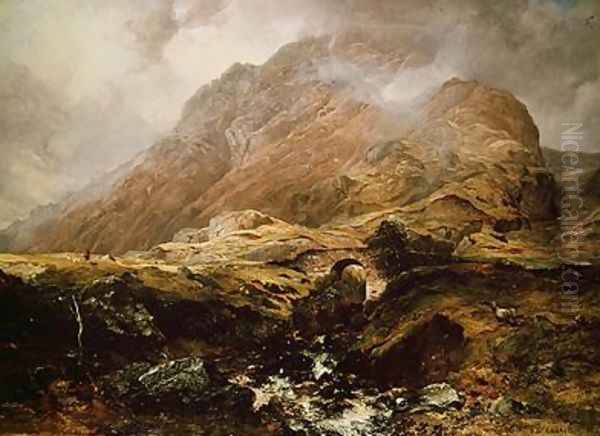
McCulloch's journey then led him to Edinburgh, the cultural heart of Scotland. There, he found work with the engraver William Lizars. His role involved hand-colouring illustrations for books, a meticulous task requiring precision and a good sense of colour harmony. This work, particularly on natural history publications, further immersed him in the detailed observation of the natural world. While working for Lizars, McCulloch was situated within Edinburgh's vibrant artistic community, interacting with other artists and amateurs, absorbing influences, and steadily developing his own artistic ambitions beyond commercial illustration and decoration.
The Transition to Landscape Painting
The move from decorative crafts and illustration colouring to becoming a dedicated landscape painter marked a significant turning point in McCulloch's career. Inspired by the dramatic natural scenery of his homeland, he began to focus his artistic energies exclusively on capturing the essence of the Scottish landscape. This transition wasn't instantaneous but evolved as he gained confidence and developed his technical abilities. The landscapes he encountered, particularly the rugged terrain of the Highlands, offered a powerful source of inspiration that resonated deeply with the prevailing Romantic sensibilities of the era.
His early training under John Knox provided a foundation, but McCulloch actively sought out other influences to shape his burgeoning style. He admired the work of Alexander Nasmyth, a foundational figure in Scottish landscape painting known for his classical compositions blended with realistic observation. Nasmyth's ability to structure landscapes while retaining a sense of naturalism likely appealed to McCulloch. Furthermore, the atmospheric effects and fluid handling seen in the watercolours of artists like Hugh William Williams (often known as 'Grecian' Williams) are also considered to have impacted McCulloch's approach, encouraging a more evocative and less purely topographical representation of nature.
McCulloch began exhibiting his landscape works, signalling his commitment to this genre. His debut at the Royal Scottish Academy (RSA) exhibition occurred in 1829. This marked his entry into the formal art establishment of Scotland. From this point forward, landscape painting became his primary focus, moving away from the decorative and illustrative work that had occupied his earlier years. He embarked on a path to interpret the Scottish scenery through his own distinct artistic lens, increasingly drawn to the untamed beauty of the Highlands.
Artistic Style and Dominant Themes
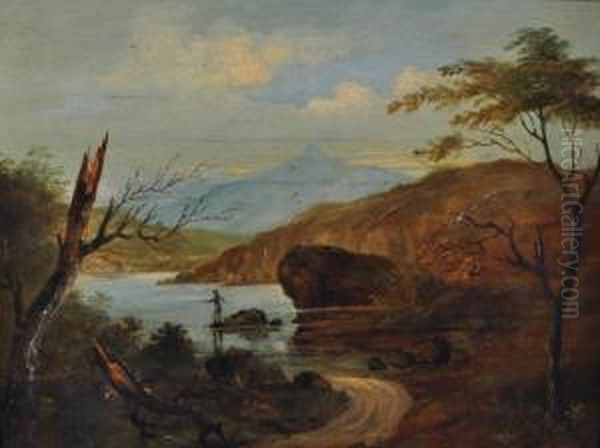
Horatio McCulloch is best known for his romanticized depictions of the Scottish Highlands. His style is characterized by a sense of grandeur, drama, and atmospheric depth. He sought to convey not just the physical appearance of the landscape, but also its emotional resonance – the feeling of awe, solitude, or tranquility inspired by the vast mountains, deep glens, and shimmering lochs. His canvases often feature strong contrasts of light and shadow, dramatic weather effects, and a meticulous attention to geological detail, albeit sometimes heightened for artistic effect.
The influence of the Romantic movement, particularly the literary works of Sir Walter Scott, is palpable in McCulloch's art. Scott's novels and poems had popularized the Highlands, casting them as a land of heroic history, ancient traditions, and sublime natural beauty. McCulloch's paintings provided a powerful visual counterpart to this literary vision. His works often depict iconic Highland locations imbued with historical or literary associations, presenting an idealized, almost mythical version of Scotland that appealed strongly to the national consciousness and the burgeoning tourist interest in the region. His Scotland was often a place of majestic wilderness, perhaps a Scotland that existed more vividly in the collective imagination, shaped by literature and art, than in strict reality.
While the Highlands were his primary muse, McCulloch did not exclusively paint wild, uninhabited scenes. He also turned his attention to depicting Scotland's changing landscape, including views that incorporated elements of urban life and burgeoning industry. Works such as Perth from the South or views incorporating the River Clyde near Dumbarton show his engagement with different facets of the Scottish environment. However, his fame rests predominantly on his Highland subjects. Paintings like Glencoe, Loch Katrine, and Inverlochy Castle became signature pieces, celebrated for their dramatic compositions and evocative portrayal of Scotland's most iconic scenery. These works cemented his reputation as the pre-eminent landscape painter of his generation in Scotland.
Working Methods and Practices
McCulloch developed a working method well-suited to capturing the essence of the expansive Scottish landscapes he favoured. Like many landscape painters of his time, he undertook regular sketching tours, particularly during the summer months. These expeditions took him deep into the Highlands and Islands, allowing him to observe firsthand the terrain, weather patterns, and light effects that characterized these regions. The West Highlands were a frequent destination, providing a wealth of dramatic subject matter.
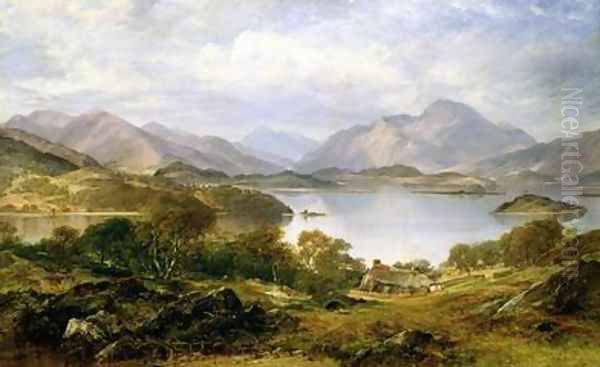
During these tours, McCulloch would create numerous sketches and studies directly from nature. These were often executed in pencil or watercolour, capturing the immediate impressions and essential features of a scene. These plein-air studies served as vital reference material once he returned to his studio. It was back in the controlled environment of his Edinburgh studio that the large-scale oil paintings, for which he is most famous, were meticulously composed and executed. He would synthesize elements from various sketches, sometimes combining features from different locations or adjusting perspectives to achieve a more dramatic or balanced composition.
His detailed approach and the popularity of his views led to collaborations. For instance, the lithographer Thomas Picken created prints based on McCulloch's depictions for publications like Scotland Delineated, which helped to disseminate his vision of the Scottish landscape to a wider audience. This practice of translating paintings into prints was common and significantly contributed to an artist's fame and the public's familiarity with their work. McCulloch's method, combining direct observation with studio refinement, allowed him to create works that possessed both a sense of naturalism and the heightened romantic drama that defined his style.
Career, Recognition, and Patronage
Following his debut at the Royal Scottish Academy in 1829, Horatio McCulloch steadily built his reputation within the Scottish art world. His evocative landscapes quickly found favour, and he became a regular and prominent exhibitor at the RSA's annual exhibitions in Edinburgh. His rising status was formally recognized when he was elected an Associate of the RSA, and subsequently, in 1838, he achieved the distinction of becoming a full Academician (RSA). This solidified his position within the highest ranks of the Scottish artistic establishment.
While deeply rooted in Scotland, McCulloch did maintain some connections with the wider British art scene. He corresponded with figures in London, potentially including the renowned English landscape painter John Constable, although the extent of their interaction is not fully detailed. Despite these connections, McCulloch rarely exhibited his work outside Scotland. A notable exception was a single appearance at the Royal Academy exhibition in London in 1843. His career remained firmly centred on Scotland, particularly Edinburgh and his native Glasgow, where he also exhibited frequently.
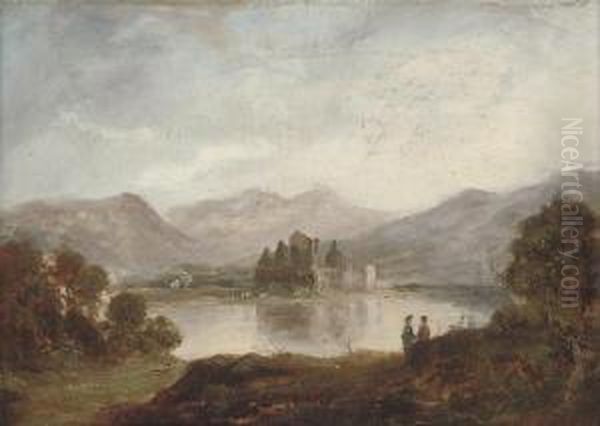
McCulloch's success was supported by a network of patrons, primarily drawn from Scotland's increasingly prosperous middle and upper classes. Lowland industrialists, merchants, and lawyers were among his key supporters. Figures like the Glasgow shipping magnate David Hutcheson were significant patrons. These collectors were often drawn to his work not only for its artistic merit but also because it depicted the Highland landscapes where many of them engaged in leisure pursuits like hunting and fishing. Early in his career, he also undertook decorative commissions, such as the work requested by James Lumsden for a public hall in Glasgow's St. George's Place, showcasing the breadth of his early artistic activities before focusing solely on landscape easel painting.
Context, Interpretation, and Influence
Horatio McCulloch's art cannot be fully understood without considering the complex social and historical context of nineteenth-century Scotland. His romanticized vision of the Highlands, emphasizing their sublime beauty and timeless grandeur, resonated with a public eager for a positive national identity, especially in the wake of the Act of Union and amidst rapid industrialization in the Lowlands. His paintings offered an escape into a seemingly unchanging, heroic landscape, aligning perfectly with the popular narratives woven by Sir Walter Scott.
However, this idealized portrayal existed alongside the harsh realities faced by the Highland population during this period. The Highland Clearances, driven by economic changes and the shift from subsistence farming to large-scale sheep grazing, led to widespread depopulation, poverty, and cultural disruption. While McCulloch's patrons from the Lowlands might have enjoyed the Highlands as a picturesque playground, his paintings generally avoided depicting the social hardships or the dramatic transformation of the landscape wrought by these economic forces. Some critics argue his work presents a sanitized, almost empty wilderness, overlooking the human cost of the changes occurring. Yet, it's also possible to read a subtle melancholy or awareness of loss in some of his more desolate scenes. His frequent visits to Skye, especially after marrying a woman from the island in 1847, would have exposed him directly to the profound economic shifts impacting the region.
Despite potential criticisms of over-idealization, McCulloch's influence was immense. He effectively defined the dominant style of Scottish landscape painting for several decades. His work was widely admired and emulated, setting a standard for depicting the national scenery. Art historians often describe him as a crucial transitional figure, a bridge between the older, more classical landscape traditions of artists like Alexander Nasmyth and the later developments in Scottish art. His style, sometimes described as "grand and ethereal," captured the public imagination and solidified a particular way of seeing and representing Scotland that proved enduring.
Contemporaries and Artistic Circle
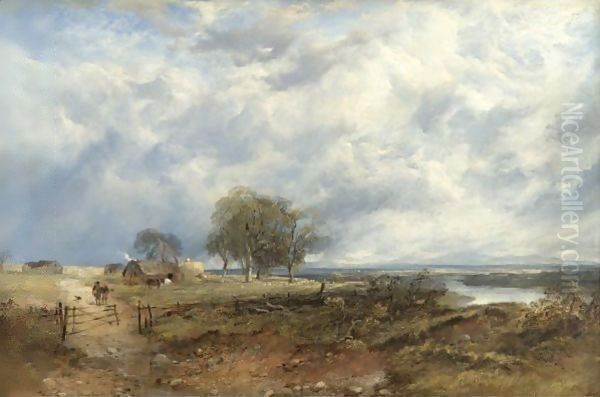
Horatio McCulloch did not work in isolation. He was part of a vibrant artistic community in Scotland, interacting with teachers, peers, and younger artists. His initial training placed him directly in contact with John Knox, his first teacher in Glasgow. In Knox's studio, and later working on decorative projects in Cumnock, he formed a lasting friendship and professional association with Daniel Macnee, who would go on to become a successful portrait painter and President of the Royal Scottish Academy. Also part of that early Cumnock group was William Leighton Leitch, who later achieved distinction as a watercolour painter and tutor, including to Queen Victoria.
His early employment in Edinburgh brought him into the orbit of the engraver William Lizars. While working for Lizars, he would have been aware of the broader Edinburgh art scene. Key influences on his developing landscape style included the foundational work of Alexander Nasmyth and the atmospheric watercolours of Hugh William ('Grecian') Williams. These artists represented the established and emerging trends in Scottish landscape art that McCulloch absorbed and synthesized.
McCulloch's network also included patrons and collaborators. Early commissions came from figures like James Lumsden in Glasgow. Later, industrialists such as David Hutcheson provided significant support. His connection to the London art world, though limited in terms of exhibition, involved correspondence with figures like John Constable. Furthermore, his popular images were disseminated through prints created by lithographers like Thomas Picken. Although not formally part of a named group or movement beyond the broad umbrella of Romanticism, McCulloch was connected through training, friendship, influence, and patronage to many key figures in the Scottish and wider British art world of his time.
Later Life and Enduring Legacy
In his later years, Horatio McCulloch continued to paint prolifically, remaining dedicated to his favoured Scottish landscape subjects. His marriage in 1847 to Marcella McLellan, who hailed from the Isle of Skye, strengthened his connection to the Hebrides. From this time onwards, Skye became a frequent destination for his sketching tours, and its distinctive landscapes began to feature more prominently in his work. This personal connection likely deepened his engagement with the Highland environment, even as the region underwent significant social and economic turmoil.
He remained based primarily in Edinburgh, maintaining his studio there and continuing to exhibit regularly at the Royal Scottish Academy, where he was a respected senior figure. His reputation as Scotland's foremost landscape painter was firmly established, and his works were highly sought after by collectors. Despite his success, he largely remained focused on the Scottish art scene, never achieving or perhaps seeking the same level of recognition in London or internationally as some of his contemporaries in other fields.
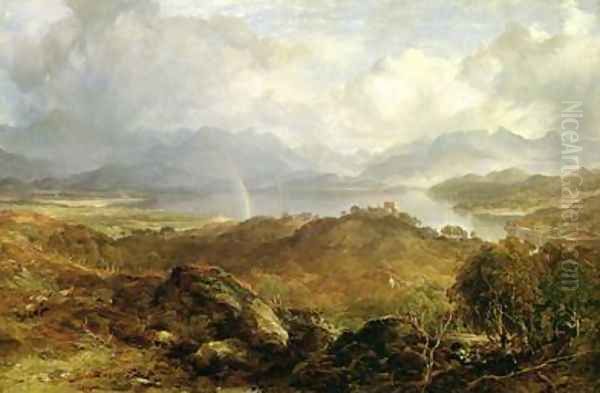
Horatio McCulloch died in Edinburgh in 1867. His death marked the end of an era in Scottish landscape painting. He left behind a substantial body of work that had profoundly shaped the visual identity of Scotland for generations. His paintings, with their blend of topographical accuracy and romantic sensibility, captured the public imagination and defined a particular vision of the Highlands that remains influential even today. While later artistic movements would move away from his highly finished, idealized style, McCulloch's importance as a key figure in nineteenth-century Scottish art and a master of the Romantic landscape is undisputed. His works continue to be admired in public collections and private hands, testaments to his skill and his enduring connection to the spirit of the Scottish landscape.
Conclusion
Horatio McCulloch occupies a central place in the history of Scottish art. As the leading landscape painter of his generation in Scotland, he crafted a powerful and enduring vision of his native land, particularly the Highlands. Emerging from a background in decorative arts and illustration, he dedicated his mature career to capturing the grandeur, drama, and romantic allure of Scotland's mountains, lochs, and glens. Influenced by predecessors like Alexander Nasmyth and contemporaries associated with the Romantic movement, including Sir Walter Scott, McCulloch developed a distinctive style characterized by atmospheric depth, detailed observation, and often idealized compositions. His works, such as Glencoe and Loch Katrine, became iconic representations of Scotland. Though sometimes criticized for presenting a sanitized view of the Highland experience, his paintings resonated deeply with national sentiment and shaped the popular perception of the Scottish landscape for decades. Connected to a network of artists including John Knox, Daniel Macnee, and William Leighton Leitch, and supported by prominent patrons, McCulloch dominated the Scottish landscape genre, leaving a legacy that continues to be recognized for its artistic skill and its profound contribution to Scotland's visual culture.